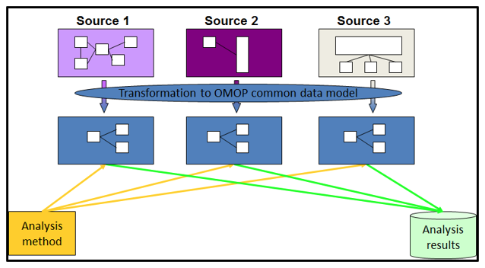Healthcare Intelligence (HI) has implemented the Observational Medical Outcomes Partnership (OMOP) Common Data Model (CDM) to support clinical analysis and research. OMOP CDM is also known as Observational Health Data Sciences and Informatics (OHDSI—say “Odyssey”) CDM. Providence is a member of the OHDSI collaborative, and this work supports our capabilities to use health data for research and operational purposes.
About OMOP
The OMOP CDM enables the systematic analysis of disparate observational databases. Data from source databases are transformed into a common format (data model) and representation (terminologies, vocabularies, coding schemes), and then systematically analyzed using a library of standard routines written for the CDM format. The library can create cohorts and allow research partners to compare medical outcomes.

Providence data sources include Epic Clinical, Cancer Registry, and Genomic Sequencing. There are two CDM components:
- 140 standardized vocabularies updated regularly with their sources and the governance needed to maintain mapping of sources to standard concepts.
- Consensus-based data model (architecture framework) to promote platform independent code and concept sharing in the member communities. Customizable and extendable model accommodating data from multiple sources, including preserved data legacy and provenance.
CDM Tools
Providence researchers, analysts, and developers can use these related tools:
- Athena: Dictionary of standard clinical concepts mapped to OMOP codes
- Atlas: Web-based analytics tool to explore concepts and define clinical cohorts
- OMOP CDM: An Azure SQL database of 12 million Providence patients with encounter-level clinical data mapped to standardized clinical concepts
- Sample queries:
Benefits of OMOP
- Standard vocabulary and code library available, including ICD-10, SNOMED, LOINC, etc.
- New datasets can be added (survey data)
- Non-developer caregivers can run characterizations (self service)
- Natural language processing (NLP) can standardize unstructured data
- Cohort definitions/concept sets are portable within Providence and with OMOP partners
More Info
- For access to Atlas or OMOP data, please submit an Application Access Request in ServiceNow for OMOP CDM-PHS.
- If you have questions, please contact John Gallardo or Roshanthi Weerasinghe.
